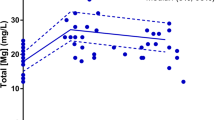Abstract
Purpose
Spironolactone is a potassium sparing diuretic used for decades. Until now, pharmacokinetic (PK) studies of spironolactone have not been conducted in infants and therefore pediatric dosing is based on expert opinion. We aimed to describe the PK profiles of spironolactone and its main metabolites (7alpha-thiomethylspironolactone (TMS) and canrenone (CAN)) in infants up to two years of age.
Methods
The PK of spironolactone and its main metabolites were evaluated following an oral administration of spironolactone (1 mg/kg/dose) to pediatric patients with chronic heart failure, ascites, and/or oedema. The plasma concentration of spironolactone and metabolites (TMS and CAN) was determined using an ultra-high performance liquid chromatography tandem mass spectrometry (UHPLC-MS/MS). Based on rich sampling PK data, the estimation of population PK parameters was performed using nonlinear mixed‐effects modelling software Monolix 2018R2.
Results
A total of 150 spironolactone, 158 TMS, and 158 CAN concentrations from 23 patients (ages: 3 days–21 months; median weight 4.3 kg (2.2–12.6)) were available for PK analysis. A one-compartment model for spironolactone, TMS, and CAN best fitted the data. The median (range) of individual estimated apparent clearance values were 47.7 (11.9–138.1) L/h for spironolactone, 9.7 (1.5–66.9) L/h for TMS, and 1.0 (0.2–5.9) L/h for CAN. The disposition of spironolactone and metabolites was mainly affected by size of the patient: body weight explained 22% of inter-individual variability of spironolactone clearance. None of the undesirable effects of spironolactone was documented during the study period.
Conclusion
The pharmacokinetics of spironolactone and its metabolites was highly variable between patients below 2 years of age. Body weight explained a significant part of this variability; this highlights the need to take it into account for dosing prescription in this population. (Clinical trial Registration Number 2013–001189-40).



Similar content being viewed by others
Availability of data and materials
The manuscript contains 2 tables, 3 figures, 2 supplemental tables and 2 supplemental figures.
References
Volz EM, Michael FG (2009) How to use diuretics in heart failure. Curr Treat Options Cardiovasc Med 11(6):426–432
Doggrell SA, Brown L (2001) The spironolactone renaissance. Expert Opin Investig Drugs 10(5):943–954
McInnes GT, Asbury MJ, Ramsay LE, Shelton JR, Harrison IR (1982) Effect of micronization on the bioavailability and pharmacologic activity of spironolactone. J Clin Pharmacol 22(8–9):410–417
Nolan Jr PE (2004) Integrating traditional and emerging treatment options in heart failure. Am J Health Syst Pharm 61(suppl_2):S14–22
Suyagh M, Hawwa AF, Collier PS, Millership JS, Kole P, Millar M, Shields MD, Halliday HL, McElnay JC (2012) Population pharmacokinetic model of canrenone after intravenous administration of potassium canrenoate to paediatric patients. Br J Clin Pharmacol 74(5):864–872
Gardiner P, Schrode K, Quinlan D, Martin BK, Boreham DR, Rogers MS, Stubbs K, Smith M, Karim A (1989) Spironolactone metabolism: steady-state serum levels of the sulfur-containing metabolites. J Clin Pharmacol 29(4):342–347
Kearns GL, Abdel-Rahman SM, Alander SW, Blowey DL, Leeder JS, Kauffman RE (2003) Developmental pharmacology—drug disposition, action, and therapy in infants and children. N Engl J Med 349(12):1157–1167
Buck ML (2005) Clinical experience with spironolactone in pediatrics. Ann Pharmacother 39(5):823–828
Takkis K, Aro R, Kõrgvee L-T, Varendi H, Lass J, Herodes K et al (2017) Signal enhancement in the HPLC-ESI-MS/MS analysis of spironolactone and its metabolites using HFIP and NH4F as eluent additives. Anal Bioanal Chem 409(12):3145–3151
Beal SL (2001) Ways to fit a PK model with some data below the quantification limit. J Pharmacokinet Pharmacodyn 28(5):481
Overdiek HW, Hermens WA, Merkus FW (1985) New insights into the pharmacokinetics of spironolactone. Clin Pharmacol Ther 38(4):469–474
de Hoogd S, Välitalo PA, Dahan A, van Kralingen S, Coughtrie MM, van Dongen EP, van Ramshorst B, Knibbe CA (2017) Influence of morbid obesity on the pharmacokinetics of morphine, morphine-3-glucuronide, and morphine-6-glucuronide. Clin Pharmacokinet 56:1577–1587
Spironolactone product monograph available at: https://www.medicines.org.uk/emc/product/1619/smpc
Spironolactone product monograph available at: https://www.medsafe.govt.nz/profs/datasheet/s/Spiractintab.pdf
Holford NH (1996) A size standard for pharmacokinetics. Clin Pharmacokinet 30(5):329–332
Acknowledgements
We would like to thank Gedeon Ricther for the donation of spironolactone powder, Dr P. Tähepõld, Dr S. Virro, and personnel of the Department of Cardiothoracic Surgery and Pediatric and Paediatric Intensive Care Unit (PICU) of Tartu University Hospital for their help in recruiting patients.
Funding
This research program was funded under the ERANet PRIOMEDCHILD program (Proposal No 40–41800-98–022).
Author information
Authors and Affiliations
Contributions
JL and SL wrote the manuscript. L-TK, HV, TM, KO, and IL participated in designing and conducting of the study. SL, JvdA, MP, and HS participated in the analysis of the study. KK, KT, and RA did the analysis of the samples. All authors reviewed the manuscript.
Corresponding author
Ethics declarations
Ethical approval
The study was approved of the Research Ethics Committee of the University of Tartu (Approval No 249[M-12).
Consent to participate and consent to publish
Individuals have been given consent to participate in a study and consent having their data published in a journal article.
Competing interests
The authors declare no competing interests.
Additional information
Publisher's Note
Springer Nature remains neutral with regard to jurisdictional claims in published maps and institutional affiliations.
Supplementary Information
Below is the link to the electronic supplementary material.
Rights and permissions
Springer Nature or its licensor (e.g. a society or other partner) holds exclusive rights to this article under a publishing agreement with the author(s) or other rightsholder(s); author self-archiving of the accepted manuscript version of this article is solely governed by the terms of such publishing agreement and applicable law.
About this article
Cite this article
Lass, J., Leroux, S., Kõrgvee, LT. et al. Pharmacokinetics of oral spironolactone in infants up to 2 years of age. Eur J Clin Pharmacol 80, 239–248 (2024). https://doi.org/10.1007/s00228-023-03599-w
Received:
Accepted:
Published:
Issue Date:
DOI: https://doi.org/10.1007/s00228-023-03599-w




